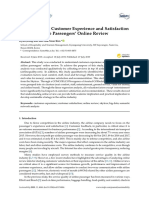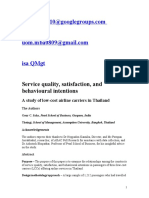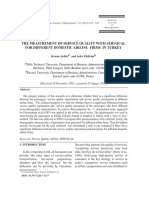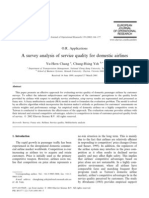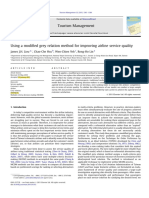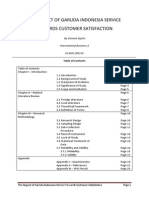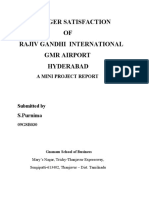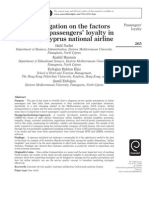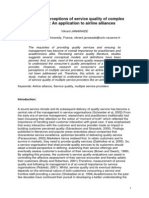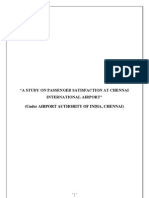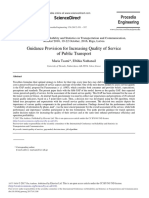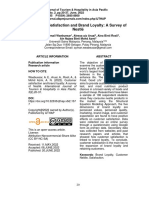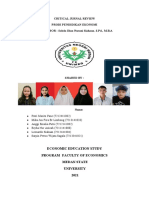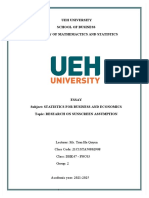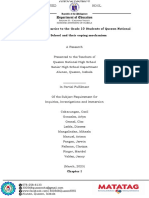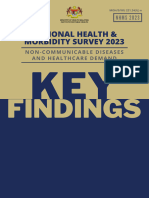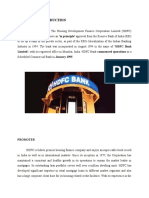Anish
Anish
Uploaded by
Anish V ChandrasekaranCopyright:
Available Formats
Anish
Anish
Uploaded by
Anish V ChandrasekaranOriginal Description:
Copyright
Available Formats
Share this document
Did you find this document useful?
Is this content inappropriate?
Copyright:
Available Formats
Anish
Anish
Uploaded by
Anish V ChandrasekaranCopyright:
Available Formats
Journal of Services Marketing
Emerald Article: Passengers' expectations of airport service quality Dale Fodness, Brian Murray
Article information:
To cite this document: Dale Fodness, Brian Murray, (2007),"Passengers' expectations of airport service quality", Journal of Services Marketing, Vol. 21 Iss: 7 pp. 492 - 506 Permanent link to this document: http://dx.doi.org/10.1108/08876040710824852 Downloaded on: 11-10-2012 References: This document contains references to 55 other documents Citations: This document has been cited by 11 other documents To copy this document: permissions@emeraldinsight.com This document has been downloaded 5495 times since 2007. *
Users who downloaded this Article also downloaded: *
Gour C. Saha, Theingi, (2009),"Service quality, satisfaction, and behavioural intentions: A study of low-cost airline carriers in Thailand", Managing Service Quality, Vol. 19 Iss: 3 pp. 350 - 372 http://dx.doi.org/10.1108/09604520910955348 Girish Prayag, (2007),"Assessing international tourists' perceptions of service quality at Air Mauritius", International Journal of Quality & Reliability Management, Vol. 24 Iss: 5 pp. 492 - 514 http://dx.doi.org/10.1108/02656710710748367 Fareena Sultan, Merlin C. Simpson, Jr, (2000),"International service variants: airline passenger expectations and perceptions of service quality", Journal of Services Marketing, Vol. 14 Iss: 3 pp. 188 - 216 http://dx.doi.org/10.1108/08876040010327211
Access to this document was granted through an Emerald subscription provided by NATIONAL INSTITUTE OF TRAINING & INDUSTRIAL For Authors: If you would like to write for this, or any other Emerald publication, then please use our Emerald for Authors service. Information about how to choose which publication to write for and submission guidelines are available for all. Please visit www.emeraldinsight.com/authors for more information. About Emerald www.emeraldinsight.com With over forty years' experience, Emerald Group Publishing is a leading independent publisher of global research with impact in business, society, public policy and education. In total, Emerald publishes over 275 journals and more than 130 book series, as well as an extensive range of online products and services. Emerald is both COUNTER 3 and TRANSFER compliant. The organization is a partner of the Committee on Publication Ethics (COPE) and also works with Portico and the LOCKSS initiative for digital archive preservation.
*Related content and download information correct at time of download.
Passengers expectations of airport service quality
Dale Fodness and Brian Murray
University of Dallas, Irving, Texas, USA
Abstract Purpose The purpose of this paper is to contribute to the development of a conceptual model of service quality in airports by conducting an empirical investigation into passengers expectations for this service industry. Design/methodology/approach The paper is a qualitative exploration of the airport experience from the passengers perspective was combined with a review of relevant literature to identify variables, to clarify basic concepts and to generate a conceptual model of airport service quality expectations. The papers quantitative research was used to develop a self-report scale to measure passenger expectations of airport service quality, to test dimensionality and to evaluate scale reliability and validity. Findings Qualitative and quantitative research on nearly 1,000 airport users provided results suggesting that passengers expectations of airport service quality is a multidimensional, hierarchical construct that includes three key dimensions: function, interaction and diversion. Research limitations/implications By bringing together different literatures and research paradigms to conceptualize service quality in a novel environment, the study contributes to the ongoing extension of service quality research. It is limited insofar as efforts to dene a global expectations construct may have homogenized results. Practical implications This paper builds on the extant literature on service quality to propose an approach for measuring passengers expectations of airport service quality that can serve as a foundation of a concise and easy-to-administer self-report measure for identifying and managing airport service quality strategies. Originality/value The paper shows that by going beyond traditional service performance measures used in the airport industry and by introducing new variables to the service quality literature, such as Csikszentmihalyis taxonomy of activity, this study broadens and enriches both practice and theory. Keywords Airports, Passengers, Customer services quality, Customer satisfaction Paper type Research paper
An executive summary for managers can be found at the end of this article.
Introduction
The airport industry is changing rapidly. Todays air travelers have meaningful choices among airports and there is an increasing urgency among airport marketers to differentiate themselves by meeting the needs of customers better than the competition. While passengers perception of airport service quality is only one of several variables (e.g. routes, scheduling, location and prices) that contribute to overall airport attractiveness, it is nevertheless an important variable because of the increasing importance of a customer orientation to competitive advantage in this industry. Aviation trade publications and airport press releases provide evidence that managers in the airport industry clearly understand the importance of their customers perceptions of service quality (Aeroporti di Roma S.p.A., 2004; Bomenblit, 2002; Gooding, 1999). Academic and
The current issue and full text archive of this journal is available at www.emeraldinsight.com/0887-6045.htm
industry researchers regularly measure passenger perceptions of airport services quality to benchmark performance metrics directly from the voice of the customer (Chen, 2002), to identify opportunities for service improvement (Yeh and Kuo, 2002) and to avoid losing valuable passenger trafc (Rhoades et al., 2000). In addition, airport marketers research passenger needs and wants for the purposes of enhancing non-aviation related revenues from restaurant and retail offerings (Danyliew and Cohen, 1997; Harrison, 1996). The nature of the expectations underlying airport service quality perceptions is unclear. Unlike the more widely accepted gap-theory model for measuring service quality (i.e. subtracting a customers perceived level of service received from what was expected), both academic and commercial airport researchers are more likely to measure service quality by establishing and monitoring service performance measures which may or may not be informed by direct customer input (Yeh and Kuo, 2002). Often, these measures are internal (e.g. number of complaints, wait/service time for baggage delivery or check-in). Internal measures of service performance are useful for benchmarking processes, but at the same time suspect because these measures are typically derived from managers rather than from passengers, thus lacking a true customer perspective. Even when service
Received: July 2005 Revised: October 2005 Accepted: December 2005
Journal of Services Marketing 21/7 (2007) 492 506 q Emerald Group Publishing Limited [ISSN 0887-6045] [DOI 10.1108/08876040710824852]
492
Passengers expectations of airport service quality Dale Fodness and Brian Murray
Journal of Services Marketing Volume 21 Number 7 2007 492 506
performance measures are external intended to measure the attitudes and opinions of customers directly the lack of a systematic understanding of airport customers expectations makes it likely that what is measured will be those attributes that are the most obvious and easy to operationalize. The net result can be a misguided effort to improve service quality in ways that are unimportant to customers, thus failing to offer the value that drives customer choice among alternatives. Not only has the airport research tradition largely ignored the gap-theory method of service quality measurement, the marketing and services literatures (the major proponents of gap-theory method service quality research) have focused little attention on airports or on passengers, a remarkably diverse group who consume in transit as they spend extended periods of time in elaborate servicescapes where they nd themselves as the result of a highly limited process of decision making. As a result, while it is possible to describe passenger preferences on issues ranging from airport signage to restroom cleanliness, there is no generally accepted theory-based model of airport service quality nor is there a comprehensive prole of the experiences, expectations and perceptual inuences of passengers in this setting. We believe that the airport industry could benet from the collective insights and the best practices of other service industries that have faced similar issues, and that the mainstream service quality literature could learn from the extension of established and emergent theory to the airports unique service environment. Therefore, the purpose of our study is to contribute to the development of a conceptual model of perceived service quality in airports by conducting an empirical investigation of the nature and role of expectations in this understudied service category. We proceed as follows. First, although airports are familiar to many, the airport business is not and so we begin with a brief industry overview. Second, we review the limited literature specic to airport quality management and passenger satisfaction. Third, we use a review of relevant literatures informed by qualitative research to categorize expectations of frequent airport users. Next, we describe the methods used to test our preliminary model, along with the results. Finally, we discuss interpretations of our ndings, explore managerial implications and suggest directions for future research.
Airport industry overview
Airports have been a consistent growth segment in the travel and transportation industry (Danyliew and Cohen, 1997). Over the last several decades, the global aviation industry has sustained annual growth rates of ve to six percent (Graham, 2003). More than 3.2 billion passengers passed through the worlds airports in 2001 (Airports Council International, 2004). North American airports account for over 40 percent of the worlds total air trafc and in excess of 3.2 million passengers transit through US airports daily (Graham, 2003). (Compare this with a more familiar services industry, hospitality, where approximately 2.6 million hotel rooms are sold daily in the US (Travel Industry Association of American (TIA), 2005).) Of the worlds 20 busiest airports, 13 are in the US (Airports Council International, 2004). Estimates are that US airports generate in excess of $380 billion a year in economic activity (Rhoades et al., 2000). Demand for air transport slowed in recent years because of the global economic downturn. Following the events of 493
September 11, 2001, airports experienced dramatic declines in passenger trafc with US airports suffering the greatest losses (Graham, 2003). When growth returns, US airport trafc is forecast to increase by nearly 60 percent by 2009, to over 1 billion passengers per year (Rhoades et al., 2000). Anticipating the need for expanded airport capacity in the US, approximately $60 billion is currently being spent on capital development projects such as runways, terminals, access roads, safety and security and noise mitigation (Federal Aviation Administration, 2005). Airport customers are remarkably varied and include passengers, airlines, employees, concessionaires, tenants and others. This study focuses on passengers (air travelers) the end users of airport facilities and services. Passenger behavior and expectations of the airport experience depend on the type of traveler, purpose of trip and his or her circumstances. Despite their differences, however, all these customers are at the airport for the sole purpose of transferring from groundbased to air modes of transportation. The airport is not a destination for air travelers. It is a transition point. At the airport, passengers encounter a bundle of tangible and intangible services in a physical setting that Bitner (1992) might characterize as an elaborate servicescape, similar to a hospital, with many corridors, queues, signs and complex interactions. It is common for passengers to spend an extended period of time in the airport servicescape, averaging over one hour once they have entered the terminal (World Airport Week, 2000). Passengers arrive at an airport as the result of a limited process of decision-making. Research and common sense indicate that the primary drivers behind an individuals choice of airport are the air services the airport offers (a combination of routes, scheduling and prices) and location (Graham, 2003). In most cases although this is changing passengers choice of airport is effectively constrained by the airlines decision of where to provide services. Marketing did not play a signicant role in the management of airports until the 1980s, prior to which time the airport was commonly viewed as a free public service or utility provided by governmental or quasi-governmental entities. Deregulation of the airlines and other sectors of the air transport industry, however, motivated airports to begin competing for airline routing. Marketing was rst introduced at airports that sought to either enlarge or protect their airline customer base. As air travelers became more sophisticated and demanding, airports came to believe that they could inuence airline routing decisions by a pull strategy of directing marketing efforts to end users, offering enhanced services or the promise of exceptional levels of customer satisfaction. As a result, by the 1990s, many airports were concentrating greater attention and investments on a wide array of marketing activities in an effort to survive in an increasingly competitive marketplace. Like many service industries, the airport industry turned to service quality as a strategy for achieving competitive advantage (Lee-Mortimer, 1993). Airport quality management and passenger satisfaction Airport service quality literature and research is distinguished from the mainstream service quality perspective (e.g. the gap theory model) by its focus on quality at the attribute level. Researchers attempting to measure airport service quality typically proceed from a list of objective indicators of service that are developed from discussions with airport stakeholders
Passengers expectations of airport service quality Dale Fodness and Brian Murray
Journal of Services Marketing Volume 21 Number 7 2007 492 506
rather than passengers, including airport and airline operators, consultants, regulators and travel industry managers. Only a limited amount of conceptual and empirical work on passengers perceptions of airport service quality exists. Rhoades et al. (2000) reviewed existing literature to develop a list of key airport quality factors from the perspective of various stakeholders. Survey data was collected from airport operators and consultants who were asked to weight the relative importance of the identied factors to airport service quality. Respondents were also asked to rate the same factors from a passenger perspective in order to gauge the extent to which their perceptions were passenger-focused (p. 258). Passengers themselves were not included in this study. Factor analysis of the data from the 150 responses received (27 percent response rate) identied four factors: passenger service issues, airport access, airlineairport interface and inter-terminal transport. Chen (2002) and Yeh and Kuo (2002), writing in the transportation literature, both approached airport service quality as a setting within which to test conceptual frameworks. Yeh and Kuo (2002) consulted Taiwanese airport managers, government ofcials, academics and travel agents to identify six airport service categories: comfort, processing time, convenience, courtesy of staff, information visibility and security. They used these categories as the basis for collecting data from 15 Taiwanese tour guides and operators. The data was analyzed using fuzzy multi-attribute decision making analysis (MADM) to demonstrate an effective alternative to performance evaluation of airport services involving subjective assessments of qualitative attributes (p. 35). Passengers were not included in this study. Chen (2002) used quality-benchmarking deployment as an approach to organize airport quality elements and passenger quality requirements. Initial items were identied from faceto-face interviews with various stakeholders (including but not limited to passengers) at Chaing Kai Shek International Airport (CKS). Items were rendered into survey questions to evaluate the performance of six major Asia-Pacic airports. The quantitative data collection sample included airline companies, forwarders, scholars and passengers. The ndings indicated that convenience of transport facilities connecting to the outside, interior design and layout and information service of the airport were critical service quality attributes. Moving from academic research to industry practice, lists of airport service attributes are developed by individual airports, industry associations and consultants for measuring airport customer satisfaction (Aeroporti di Roma S.p.A., 2004; Airports Council International, 2004; Bomenblit, 2002; J.D. Power, 2000). A typical example is the syndicated AETRA customer satisfaction survey, a joint undertaking of Airports Council International (ACI) and the International Air Transport Association (IATA). According to the AETRA Web site, the information provided helps their users (airport managers) understand how they perform and how to improve as they continue to adopt market oriented business strategies (AETRA, 2005). The ongoing AETRA study is based on a self-completion questionnaire distributed to passengers at departure gates and covers a number of aspects of passengers on-the-day airport experience including: navigation, airport services and facilities, security and immigration, airport environment and airline services. Lists of attributes such as these can and do provide airport managers with useful information, but do not represent 494
service quality as the concept has come to be understood in marketing and services research and literature. Although the cited studies and others like them do a good job of identifying objective service attributes, they do not address passengers expectations or the underlying dimensionality of the service quality construct from a theory-based perspective, which is at the heart of the mainstream service quality literature. To summarize the current state-of-affairs of service quality theory and practice in the airport industry, compelling reasons for managing airport service quality exist and airport service attributes are commonly measured. However, a widely accepted, integrated theory/model of the dimensionality of passenger expectations driving airport service quality perceptions is lacking. Leaving aside the more academic questions this theory gap raises, from a practical airport marketing perspective airport managers need a valid and reliable scale (that is also concise and easily administered) for measuring airport service quality in order to: . assess customer expectations about and perceptions of airport service quality at individual airports as well as at those of its competitors; . identify and prioritize service areas requiring managerial attention and action to ensure and improve service quality and customer satisfaction; and . provide the airports managers with indications of how to establish and sustain competitive advantage based on a service quality strategy. In the remainder of this paper, research designed to develop and test a scale to investigate passengers expectations of airport service quality is described. Both qualitative and quantitative studies using airport passengers as samples were performed to develop the expectations survey item pool, to investigate dimensionality of service quality expectations in the airport environment and to assess the resulting models validity and reliability. We begin by combining a qualitative exploration of the airport experience from the passengers perspective with a review of relevant literature to identify variables, to clarify basic concepts and to generate hypotheses in the form of a preliminary conceptual model of airport service quality expectations. Quantitative research was used to develop a self-report scale to measure passenger expectations of airport service quality, to test for dimensionality and to evaluate reliability and validity as prescribed by Churchills (1979) paradigm for the development of self-report scales.
Airport service quality expectations: model development
Generating airport service quality themes from passengers Consistent with accepted practice in marketing and service quality research (Brady and Cronin, 2001; Dabholkar et al., 1996; Zeithaml et al., 1993), we rst conducted qualitative research on the passenger airport experience to gain an understanding of the dimensions of passengers expectations of airport service quality. These studies were designed to develop rather than to test hypotheses because the airport quality management and passenger satisfaction literatures lack established theory suggesting formal relationships among the variables of interest. In addition, neither SERVQUAL nor any of its related operationalizations of the gap-theory model for measuring service quality have been suggested for or adapted
Passengers expectations of airport service quality Dale Fodness and Brian Murray
Journal of Services Marketing Volume 21 Number 7 2007 492 506
to airports (see, however, Heung et al., 2000 for an application of SERVQUAL to airport restaurants). Thus, the qualitative studies sought insights by collecting and analyzing observations about personal airport experiences and expectations from passengers. The approach of this qualitative research was to investigate quality factors the air traveler expects from an airport service encounter, to explore air traveler experiences and problems and to identify the importance of specic airport service expectations that might contribute to perceived service quality or to preferences for one airport over another. The research probed service quality outcomes, satisfaction and other intangibles of airport expectations, along with facilities and more tangible aspects of airports physical settings. In addition to providing the data for development of preliminary conceptual bases for passengers expectations of airport service quality, this phase of the research generated an item pool for the construction of a related expectations measurement instrument. Three different qualitative methodologies in-depth interviews, focus groups and content analysis of verbatim comments were used to focus on passenger expectations of airport service quality. The sampling frame, number of responses received and key respondent characteristics are indicated in Table I. Participants in the in-depth interviews and focus groups were asked about their expectations of and experiences at airports in general, as well as their attitudes toward and their opinions of specic airports with which they were familiar. Those who responded with comments at an airport web site also were asked to respond to the open-ended question, What is your favorite airport and why?. Content analysis was applied to the data generated from all three qualitative methodologies and, in accordance with Herek (1987), an airport service quality theme was dened by any idea or complete thought somehow related to the respondents reason for satisfaction or dissatisfaction with the airport experience. Results from the three qualitative studies were compiled to create a master list of airport service quality themes. Multiple mentions of the same theme were eliminated. The nal list of 65 airport service quality themes appears in the following list: 1 An airports physical layout should make it easy for passengers to nd what they need (i.e. restaurants, restrooms, gates, etc.). 2 I do not expect to walk long distances to get where I am going in the airport terminal. 3 Conference facilities should be available to me at an airport so that I can conduct meetings. 4 I would use a church/chapel in an airport during a layover. Table I Qualitative research
In-depth interviews Sampling frame Passengers in terminal waiting areas of a major Southwestern airport 100 passengers Actively engaged in the airport experience at the time of interview
5 6
7 8 9 10 11 12 13 14 15
16
17 18 19 20 21 22 23 24 25 26 27 28 29 30
An airport should display art. It upsets me when I have to go back-and-forth through security to access airport services (retail shops, food outlets, etc.). An airport should have quiet areas in which to nap, read, or do business. Airport employees should show an interest in solving my problems. I should expect to pay more in restaurants and snack bars at an airport. Banking services should be available at airports. A variety of ground transportation options to the nearest city should be available. Airport security measures are a waste of my time. I expect to pay more at retail outlets at an airport. An airports decor should match the local culture of the city at which it is located. Airport facilities and amenities (i.e. restaurants, restrooms, and shops) should be conveniently located near gates and in every terminal. It is important to me for the public announcement / paging system to be audible in all areas of an airport terminal, including restaurants, retail stores, and curbside check-in. I feel airports should have more ight information displays in the terminals. A variety of food choices should be available at airports. I nd electric passenger transfer carts to be convenient when changing planes. There should be an automated means of obtaining information on local attractions at an airport. Opportunities to enjoy the local cuisine should be available at airports. Nationally known retail outlets should be available at airports. It upsets me when I have to wait more than ten minutes to receive my baggage after a ight. I should be able to walk to the parking lot from the terminal at an airport. Childrens play areas should be available in airport terminals. An airports terminal should be designed so that waiting lines are minimized. An airport should have business centers, which provide personal computers, phones, and faxes. An airport should offer services such as massage booths, salons, and recliner lounges. Employees at the airport should be neatly dressed. There should be an automated means of obtaining information on local hotels at an airport.
Methodology Focus groups Frequent yers in Los Angeles, Dallas and Miami 72 frequent yers (six focus groups total; two in each location) Platinum-level American Airlines frequent yer status
Verbatim comments Visitors to the web site of a major Southwestern airport 1,500 comments Submitted comments at airport web site without urging or incentive
n
Key respondent characteristics
495
Passengers expectations of airport service quality Dale Fodness and Brian Murray
Journal of Services Marketing Volume 21 Number 7 2007 492 506
31 32
33 34 35 36 37 38 39 40 41 42 43 44 45 46 47 48 49 50 51 52 53 54 55 56 57 58 59 60 61 62 63 64 65
An airports external signs should clearly direct me to airport services such as parking, car rentals, terminals, etc. I like many signs to be visible throughout an airport directing me to airport facilities (baggage, ticket counters, security, rest rooms, rental cars, transportation services, etc.). Employees at an airport should never be too busy to respond to my requests promptly. I expect baggage carts to be conveniently located. It upsets me when I have to wait in line more than ten minutes during the check in process. I trust airport employees. I should be able to exit the airplane within ten minutes of landing. Moving walkways and escalators should be located throughout the terminal. An airport should have current decor. Employees at the airport should be able to direct me to any airport service. There should be employees at an airport available to offer me individualized attention. National chain restaurants should be available at airports. An airport should be clean. I am often confused by ight information displays. An airports waiting areas should provide comfortable seating. An airports rest rooms should offer baby changing tables. I expect to nd a variety of specialty retail stores that portray the local culture at the airport. I feel airports should have ight information displays outside of the terminals (i.e. parking lots, access roads). An airport should have soothing music playing throughout its facilities and terminals. The way an airport employee is dressed should easily identify their function. I would use a gym during a layover at an airport. I expect employees at an airport to be courteous. Airports should house educational museums for passengers to enjoy during layovers. Employees at an airport should keep me informed of any changes that may occur. At airports, the excessive number of signs often confuses me. An airport should offer as much natural light through windows, skylights, etc. as possible. I expect my complaints to be responded to immediately at an airport. An airport should have many windows to view airplanes taking off and landing. An airport should have plenty of open spaces to prevent crowding. Employees at an airport should be knowledgeable about local areas of interest. An airport should have designated smoking areas. I expect employees at the airport to greet me with a smile. I expect to nd baggage claim services close to the gate. Mail facilities should be available at airports, including postage machines and drop boxes. I should be able to easily reach my connecting ight. 496
(Airport themes are presented as they were re-written for the questionnaire in order to save space. Italicized items were retained in the nal model.)
The airport service quality construct
We constructed out preliminary conceptual model of the expectations of the airport experience using data obtained from the passengers in our qualitative research and from the proscriptions provided by relevant literatures. The marketing and services literatures were chosen as appropriate. We also selected motivational psychology for its insights into how individuals allocate their waiting time, which passengers at airports often have in excess. This combination yielded both preliminary dimensions of airport service quality expectations and an item pool for developing a survey instrument. This approach is well documented in qualitative research in service quality (see Dabholkar et al., 1996). It also resulted in the exclusion of some items from the original master list of airport service quality themes. For example, if passengers identied directional signage at the airport as a key expectation and the literature provided either conceptual or empirical support for this theme, it was included. If they mentioned expectations of higher prices at airports, it was excluded if not supported or suggested by our focal literatures. The literature itself suggested certain relevant concepts, such as whether interactions with fellow passengers inuenced expectations of airport service quality. If, as in this case, such themes were not present in the qualitative ndings, they were not included.
A preliminary conceptual model of airport service quality expectations
Our resulting model of airport service quality expectations is composed of three primary dimensions servicescape, interaction and services (see Figure 1). Further, the model suggests that each dimensions has three subdimensions. Similar hierarchical structures for perceived service quality in other settings have been reported (Brady and Cronin, 2001; Dabholkar et al., 1996). Brady and Cronin (2001) offer a plausible explanation:
. . . customers form their service quality perceptions on the basis of an evaluation of performance at multiple levels and ultimately combine these evaluations to arrive at an overall service quality perception (p. 37).
Dimension 1: services For services that require customers to be present in the service factory for extended periods of time, Bitner (1992) theorized that the facility itself the servicescape has a signicant inuence on overall service encounter quality perceptions. The servicescape includes all the objective factors controllable by the service provider that facilitate customer actions during the service encounter and enhance their overall service quality perception. Research has documented the inuence of the physical environment on service quality perceptions in restaurants (Rys et al., 1987), retail stores (Dabholkar et al., 1996), and a variety of other service businesses (Brady and Cronin, 2001). Because airports require passengers physical presence and often a signicant time commitment, the physical environment of the airport can inuence perceptions of the overall quality of the service encounter. For example:
. . . assume that a traveler enters an airport and (1) is confused because he or she cannot nd signage giving directions to the assigned gate and (2) is
Passengers expectations of airport service quality Dale Fodness and Brian Murray
Journal of Services Marketing Volume 21 Number 7 2007 492 506
Figure 1 Preliminary conceptual model for airport service quality
emotionally distressed because of crowds, poor acoustics and high temperatures. Here the servicescape directly impacts the travelers evaluation of the quality of his or her airport experience (Bitner, 1992, p. 61).
As approximately half of the airport service quality themes (see previous list) were identied as representing Bitners servicescape dimensions, the rst primary airport service quality expectations dimension we propose is servicescape. H1. Passengers expectations of the servicescape directly inuence their airport service quality perceptions. The basic servicescape construct includes three key elements: spatial layout and functionality, ambient conditions and signs/ symbols. Spatial layout and functionality refers not only to the arrangement and relationships of machinery, equipment and furnishings, but also to the ability of these to facilitate performance and the accomplishment of service customer goals. This dimension is considered to be of particular importance because the physical settings of service encounters are purposeful environments that exist to fulll specic needs of service customers. Ambient conditions are factors (e.g. temperature, lighting, noise, music and scent) that affect perceptions of the environment. Empirical studies conrm that these factors inuence service quality perceptions of restaurants (Milliman, 1986) and retail venues (Milliman, 1986; Yalch and Spangenberg, 1988). Signs and symbols communicate explicit (i.e. posted labels, directions and rules) or implicit (quality of materials and furnishings) meaning about the physical environment. Our qualitative research yielded clear evidence for all three components of servicescape. The rst servicescape subdimension combines elements of both spatial layout and functionality, readily recognizable from Bitners (1992) description of the servicescape. It makes intuitive sense that these two concepts should be very closely related as together they capture how well the airport layout facilitate(s) performance and the accomplishment of goals (Bitner, 1992) The importance of facility layout to perceived service quality has been empirically established (Baker et al., 1994; Brady and Cronin, 2001; Dabholkar et al. 1996). Participants in the in-depth interviews and focus groups consistently stressed the critical importance of being able to nd their way through the airport to either their departure gate, facilities (i.e. restrooms) or amenities (i.e. shops and snack bars). At the web site, comments relevant to this dimension included, I like the setting its easy to nd everything, easy access to everything, and Airport is designed so gates are close 497
together. As suggested by the literature review, and reinforced by the qualitative studies, spatial layout and functionality was proposed as the rst servicescape subdimension of our model. H2. Passengers expectations of spatial layout and functionality inuence their airport service quality perceptions. Our second proposed servicescape subdimension is ambient conditions, similar to Bitners (1992) original dimension. While relatively few themes were generated around this aspect of the airport experience, passenger respondents in all three qualitative studies specically mentioned them. Themes included: An airport should be clean, An airport should have soothing music playing throughout its facilities and terminals, and An airport should offer as much natural light through windows, skylights, etc. as possible. In other service settings, ambient conditions have been found to have either stressful or relaxing effects on customers (Milliman, 1982, 1986; Yalch and Spartenberg, 1988), and we propose that they also play a role in expectations underlying service quality perceptions of airports. H3. Passengers expectations of ambient conditions inuence their airport service quality perceptions. The third subdimension we propose, signs and symbols, once again closely resembles the original Bitner (1992) dimension and addresses both explicit signals (signage) and implicit signals (decor). The role of signage in perceived service quality has been established in research (Callan and Kyndt, 2001). Passengers in the three qualitative studies stressed the importance of both informational signage (ight information displays or FIDS) and directional signage An airports external signs should clearly direct me to airport services such as parking, car rentals, terminals, etc. As a symbol, airport decor was the sole implicit signal specically mentioned by passengers in all three qualitative studies and it is a recurring theme in retail service quality research, as well (Dabholkar et al., 1996). Comments included: An airport should display art, An airports decor should reect the local culture of the city at which it is located, and An airport should have current decor. These themes, along with ndings from related research, support our inclusion of signs and symbols as a servicescape subdimension in the model. H4. Passengers expectations of signs and symbols inuence their airport service quality perceptions.
Passengers expectations of airport service quality Dale Fodness and Brian Murray
Journal of Services Marketing Volume 21 Number 7 2007 492 506
Dimension 2: service providers A second inuence on service quality perceptions where customers physical presence is required for service delivery is interactions with service personnel (Bitner, 1990, 1992; Brady and Cronin, 2001; Brown and Swartz, 1989; Dabholkar et al., 1996; Elliott, 1995; Groonroos, 1982; Saleh and Ryan, 1991; Surprenant and Solomon, 1987). The most widely known and discussed means used to measure consumer perceptions of service interaction quality is SERVQUAL, a multi-attribute scale commonly comprised of ve dimensions: tangibles, reliability, responsiveness, assurance and empathy (Cronin and Taylor, 1992; Oh and Parks, 1997). Although the intended scope of SERVQUAL extends beyond service customer provider interactions, three of the dimensions explicitly focus on the relational aspects of service quality (responsiveness, assurance, empathy) and the remaining two (tangibles and reliability) touch upon customer contact personnel issues as well. SERVQUAL has been applied and tested in a number of empirical studies involving services with elaborate servicescapes, including hotels (Saleh and Ryan, 1991; Getty and Getty, 2003), restaurants (Bojanic and Rosen, 1994; Heung et al., 2000), health clinics (Babackus and Mangold, 1989), hospitals (Carman, 1990), banks (Spreng and Singh, 1993) and airlines (Elliott, 1995). Despite the lack of a previous application of SERVQUAL to airports, perceptions of service quality for other services with elaborate servicescapes and for airport environments are likely to share some common dimensions in the area of service interactions and similar inuences on service quality perceptions. Therefore, the second dimension proposed for our model of airport service quality expectations is service providers. H5. Passengers expectations of the interactions with service providers directly inuence their airport quality perceptions. Our service providers dimension partially resembles the original Parasuraman et al. (1988) SERVQUAL construct. Nearly a quarter of the themes generated by passengers in the qualitative study were clearly identiable as SERVQUAL dimensions. Included were cites to tangibles (The way an airport employee is dressed should easily identify their function), responsiveness (Employees at an airport should never be too busy to respond to my requests promptly), assurance (I expect employees at an airport to be courteous) and empathy (There should be employees at an airport available to offer me individualized attention). While our service providers dimension does contain elements of the original Parasuraman et al. (1988) SERVQUAL construct, there is an alternative that better ts the observed data. Brady and Cronin (2001), as well as others (Bitner, 1990; Bitner et al., 1990; Czepiel et al., 1985; Groonroos, 1990), have provided conceptual and empirical support for three distinct factors that underlie consumer perceptions of their interactions with service providers: attitudes, behavior and expertise of the service provider. Without exception, the service provider interaction themes generated by the qualitative sequence of studies referred to one of these three factors. H6. Passengers perceptions of the attitudes of service providers inuence their airport quality perceptions. H7. Passengers perceptions of airport service quality are inuenced by their expectations of employee behavior. 498
H8.
Expectations of employees expertise inuence passengers perceptions of airport service quality.
Dimension 3: services The necessity for passengers to be physically present in the airport emphasizes issues of time and of how time is spent. Servicescape theory addresses this in terms of spatial layout and functionality. SERVQUAL focuses on time spent waiting. Neither servicescape nor SERVQUAL, however, address larger issues of how the customers time is allocated or invested. Because the airport experience demands a signicant time commitment and for many passengers time is the ultimate scarce resource the extent to which the airport facilitates or frustrates their use of time can have a signicant inuence on perceptions of the overall quality of the service encounter. Research shows that once a passenger has entered the terminal his or her average wait can exceed one hour (Darko, 1999). Factors such as ight delays and cancellations due to security, breakdowns and weather, can prolong time spent at the airport. Research also has highlighted the importance of time spent waiting at airports (Darko, 1999), especially to business travelers. Given the value of time spent waiting to many passengers, more favorable perceptions of airport service quality may be associated with airport options that provide them with greater control over how they experience their waiting time. This raises the question, What would passengers choose to do with the time they spend waiting in airports?. A body of work (e.g. Csickszentmihalyi and Graef, 1980; Larson and Richards, 1994) documents that what people do with their time can be divided into three major activities: productive, maintenance and leisure. Depending on their stage in the life cycle and employment status, many people spend much of their time engaged in productive activities such as job-related work or education-related study. Another signicant chunk of time is taken up by maintenance activities directed at both peoples bodies (e.g. eating, resting, grooming) and their possessions (e.g. housework, shopping). Discretionary time left over from productive or maintenance activities, is available for leisure pursuits. Three primary forms are: media consumption such as watching television, listening to music or reading; conversation; and more active leisure including hobbies, sports, exercise and going out to restaurants, movies and the mall. Thus, research suggests that passengers at the airport have the potential for actively seeking to achieve goals and objectives related to work, related to keeping their body and possessions functioning properly and related to whatever they do with their free time. It is within these three domains of activity that the airport experience can facilitate or frustrate how passengers choose to use their precious time spent waiting. How well it does at either can have a signicant inuence on perceptions of the overall quality of the airport service encounter. Thus, the third dimension in our model of airport service quality expectations is the services offered by the airport. H9. Passengers perceptions of airport service quality are directly inuenced by their expectations of how airport services will facilitate their activities during the time that they are physically present at the airport. Passengers in all three qualitative studies consistently generated themes that identied services needed or wanted during the time that they were at the airport. Comments such
Passengers expectations of airport service quality Dale Fodness and Brian Murray
Journal of Services Marketing Volume 21 Number 7 2007 492 506
as An airport should have business centers which provide personal computers, phones and faxes and Conference facilities should be available to me at an airport so that I can conduct meetings all clearly relate to productive activities. Csikszentmihalyis (1997) typology specically identies shopping and eating out as maintenance activities. Passengers in the qualitative research listed both. Comments included: Nationally known retail outlets should be available at airports and A variety of food choices should be available at airports. Themes related to leisure activities identied in all three qualitative studies included An airport should offer services such as massage booths, salons and recliner lounges and Airports should house educational museums for passengers to enjoy during layovers. Thus, our qualitative data support Csikszentmihalyis (1997) typology, because passengers consistently cited services that could be easily identied as important to activities in one of these activity areas. To summarize, we propose a hierarchical factor structure for airport service quality with three basic dimensions, with overall service quality as a second-order factor. Further, each of the three dimensions have three subdimensions each (see Figure 1).
were large hub airports (DFW, ATL, DEN) as well as smaller airports (DAL, HNL, LAS). Analysis To test the hypotheses, data were analyzed using both exploratory and conrmatory factor analysis (CFA). Exploratory factor analysis was used to explain the pattern of correlations within the set of observed variables and to compare those empirical results against each of the three dimensions in our expectations model (Figure 1). CFA was then used to conrm the second-order dimensionality suggested by the qualitative research and literature review, as modied by the results of the exploratory factor analysis.
Results
Exploratory factor analyses The scales used to test our dimension/subdimension hypotheses were: servicescape (H2-H4), service personnel (H6-H8) and services (H10-H12). In order to determine whether the items as we assigned them actually do represent the dimensionality suggested from the combined literature review and qualitative research, the items comprising each separate scale were subjected to a maximum likelihood exploratory factor analysis. For each of the three scales, exploratory factor analysis initially resulted in a number of factors, retention of which was at rst based on whether the individual factor had an eigenvalue greater than or equal to one. The reduced factor solution for each scale was then subjected to a varimax rotation seeking more easily interpretable results. While the varimax rotation produced interpretable loadings, each scale also contained items that loaded highly on more than one factor. As per Churchill (1979), only items that loaded on a single factor were selected for the nal version of the scale. Also, in all three scale solutions some items failed to load on any factor at the 0.6 level or higher and were removed. Items were reduced and sub-dimensions were modied for each scale in an iterative process. Next, coefcient alphas and item-to-total correlations were calculated for each scale. Where values of coefcient alpha indicated that further deletion of items would improve the alpha value, this was done. Recomputation of alphas and item-to-total correlations and reexamination of the factor structures were repeated. Final results are presented in Tables II-IV. Results both supported our preliminary conceptual model for passengers expectations of airport service quality and also suggested modications. The following section details how and why our original model was re-specied to accommodate both theory and data. Servicescape Table II presents the results of an exploratory (maximum likelihood) factor analysis on the servicescape scale. A twofactor solution was identied. The rst factor contains items from the original sub-dimensions of spatial layout and functionality and signs and symbols. As the servicescapes role in the effective movement of the passenger through the airport seems to be an underlying theme among the items loaded on the rst factor, effectiveness provides an apt label for this factor. Items that loaded on the second factor represent passengers concern with the timeliness of their movement through the airport and this factor has been 499
Airport service quality expectations: test of the model
Research methodology The purpose of this quantitative study was to design, implement and test an objective approach to measuring passengers expectations of airport service quality. Item generation and scale development All 65 airport service quality themes generated by the indepth interviews, focus group discussions and Web site comments (described in the qualitative sequence of studies) were rewritten as questionnaire items (see previous list) to form an original scale that was used to collect data from a sample of frequent yers. Each airport service quality theme was paired with a seven-point scale ranging from Strongly Agree (7) to Strongly Disagree (1). Data collection Data for the quantitative sequence of analyses were collected from a purchased list of 1,765 frequent yers (dened as three or more air trips per year) with an annual income over $50,000. The sampling frame was nationwide in scope and consisted of an equal percentage of males and females. Approximately 33 percent, or 753, of the 1,765 surveys mailed out were returned. The analytic techniques used in this study are sensitive to missing data and for that reason casewise deletion was used to remove 53 cases. Even after removal of unusable cases, this response rate is high compared to other mail surveys reported in recent marketing literature, but about average for travel, tourism and hospitality studies. No incentive was offered to respondents. The responses (n 700) contained a nearly equal number of females and males. The age of the respondents ranged from 17 to 75 with an average age of 48 years. Respondents reported an average of nearly four pleasure trips and nine business trips by air within the past year. Approximately 55 percent of the respondents named one of ten airports as their home airport. Included in the top ten airports mentioned
Passengers expectations of airport service quality Dale Fodness and Brian Murray
Journal of Services Marketing Volume 21 Number 7 2007 492 506
Table II Servicescape: Results of exploratory factor analysis
Items An airports external signs should clearly direct me to airport services such as parking, car rentals, terminals, etc. (31) I like many signs to be visible throughout an airport directing me to airport facilities (baggage, ticket counter, security, rest rooms, rental cars, transportation services, etc. (32) An airports physical layout should make it easy for passengers to nd what they need (i.e. restaurants, rest rooms, gates, etc.) (1) A variety of ground transportation options to the nearest city should be available (11) I expect baggage carts to be conveniently located (34) I should be able to easily reach my connecting ight (65) It upsets me when I have to wait more than ten minutes to receive my baggage after a ight (23) It upsets me when I have to wait in line more than ten minutes during the check-in process (35) I should be able to exit the airplane within ten minutes of landing (37) Reliability coefcient (alphas) Eigenvalue Percent of variance explained Cumulative percent of variance explained Factor 1 Effectiveness Factor 2 Efciency 0.103 0.149 0.056 0.206 0.092 0.271 0.864 0.860 0.626 0.73 2.037 22.630 58.907
0.852 0.807 0.748 0.651 0.648 0.616 0.055 0.117 0.295 0.81 3.265 36.277 36.277
Table III Service personnel: results of exploratory factor analysis
Items I expect employees at an airport to be courteous (52) Employees at an airport should be neatly dressed (29) The way an airport employee is dressed should easily identify their function (50) Employees at the airport should be able to direct me to any airport service (40) I expect my complaints to be responded to immediately at an airport (57) There should be employees at an airport available to offer me individualized attention (41) Employees at an airport should never be too busy to respond to my requests promptly (33) There should be an automated means of obtaining information on local attractions at an airport (20) Employees at an airport should be knowledgeable about local areas of interest (60) There should be an automated means of obtaining information on local hotels at an airport (30) Reliability coefcient (alphas) Eigenvalue Percent of variance explained Cumulative percent of variance explained Factor 1 Access 0.777 Factor 2 Problem-solving 0.239 0.139 0.133 0.394 0.823 0.758 0.697 0.100 0.247 0.097 0.74 2.069 20.685 44.757 Factor 3 Advice 20.065 0.170 0.257 0.256 0.088 0.266 0.113 0.849 0.717 0.680 0.70 1.953 19.533 64.291
0.768 0.689 0.615 0.178 0.131 0.384 0.029 0.117 0.387 0.76 2.407 24.027 24.027
Table IV Services: results of exploratory factor analysis
Items Nationally-known retail outlets should be available at airports (22) National chain restaurants should be available at airports (42) Opportunities to enjoy the local cuisine should be available at airports (21) I expect to nd a variety of specialty retail stores that portray the local culture at the airport (47) An airports waiting areas should provide comfortable seating (45) An airport should be clean (43) An airport should have plenty of open spaces to prevent crowding (59) An airports decor should match the local culture of the city at which it is located (14) An airport should display art (5) An airport should have current decor (39) Conference facilities should be available to me at an airport so that I can conduct meetings (3) An airport should have business centers, which provide personal computers, phones and faxes (27) An airport should have quiet areas in which to nap, read, or do business (7) Reliability coefcient (alphas) Eigenvalue Percent of variance explained Cumulative percent of variance explained Factor 1 Factor 2 Factor 3 Factor 4 Maintenance Ambiance Decor Productivity
0.827 0.800 0.684 0.656 0.080 0.011 0.152 0.159 0.071 0.267 0.106 0.260 0.068 0.80 4.074 31.34 31.34
2 0.049 0.039 0.195 0.059 0.082 0.343 0.104 0384 0.817 0.089 0.809 0.010 0.737 0.191 0.758 0.213 0.682 2 0.079 0.667 0.154 2 0.020 0.098 0.184 0.096 0.426 0.174 0.72 0.61 1.762 1.203 13.55 9.257 44.890 54.147
0.238 0.129 0.106 0.028 0.093 0.025 0.021 2 0.051 0.341 .060 0.856 0.727 0.547 0.61 1.074 8.263 62.410
500
Passengers expectations of airport service quality Dale Fodness and Brian Murray
Journal of Services Marketing Volume 21 Number 7 2007 492 506
labeled efciency. No items from the original ambiance sub-dimension were retained by the analysis. Based on these results, the primary servicescape dimension is retained in the re-specication of our original model, but has been renamed function to more accurately reect the items retained and factors generated. In addition, the effectiveness and efciency factors replace the original spatial layout and functionality, ambient conditions and signs and symbols sub-dimensions. Service personnel Our original service personnel dimension specied three subdimensions: attitudes, behavior and expertise. The results of the exploratory factor analysis on the original service personnel scale, including items that failed to load meaningfully on either of the other two original scales, suggest an interesting modication that both contracts and expands our initial conceptualization (see Table III). The items that loaded on all three factors are mainly related to the behavior subdimension from our initial model. The rst factor is made up of items that, collectively, can be interpreted as service personal behaviors that facilitate access of passengers to them. The second factor is clearly about the service personnels problem-solving behavior. The third factor is perhaps the most intriguing. It is mostly composed of items originally placed in the signs and symbols subdimension of the original model, where they failed to load meaningfully. When added to the service personnel scale, however, they combined with employee behavior related to advice on services available in the local area. In the re-specication of our initial model, the term service personnel is replaced with interaction to more accurately reect the factors generated by our analysis: access, problem-solving and advice. Services Results from the exploratory factor analysis of the services scale are presented in Table IV. As shown, a four-factor solution was generated. This factor pattern was produced when the items from the original ambiance subdimension which failed to load as initially specied under the primary servicescape dimension were added to the services scale. The rst factor (maintenance) and the fourth factor (productivity), reecting Csikszentmihalyis domains of activity, remain relatively unchanged from the initial model. The items loaded on the second factor are all from the original ambiance subdimension and relate to the feeling of a particular airport setting. The third factor contains items also from the original ambiance scale, but of a more tangible nature, describing the decor of an airport. Taken together, these four factors suggest an underlying construct more complex than the original services dimension. The combination of ambiance-related factors along with the activity-related factors may be describing an environment perceived by the passenger as offering opportunities for aesthetic, cognitive and sensory satisfaction. Such an environment is no doubt of special importance to consumers who, as a necessary condition of their consumption of a service product (the airport), are required to spend relatively large amounts of time there. This interpretation of the results led to a revision of the primary dimension label from services to diversion, reecting a turning aside from focusing on the fact that the passenger is, in effect, trapped in the airport servicescape toward 501
activities that redirect their attention or stimulate them aesthetically. Based on the results of the exploratory factor analysis, our preliminary airport service quality expectations model was revised and specied as a second-order factor model (see Figure 2). Conrmatory factor analysis The revised structure pattern of the remaining items was evaluated through a conrmatory analysis using AMOS 4.01 (Analysis of Moment Structures). We applied the traditional structural equations approach, total disaggregation, using each item as a separate indicator of the relevant construct thus providing the most rigorous and detailed level of analysis. Submission of the model specied by Figure 2 failed to achieve a feasible solution. Modications were made by removing latent variables in an iterative fashion and re-testing the resulting model. As a result, access, advice and ambiance subdimensions were eliminated from the nal model. Access and ambiance, upon closer inspection, were both concerned with generic service issues that were not specic to the airport. The items contained in advice were more focused on destinations than on airports. The revised structure pattern of the remaining items was then evaluated and an acceptable t was found (x2 =df 3:631, GFI 0:912, AGFI 0:889, CFI 0:894, RMSEA 0:068) for the model shown in Figure 3. The unidimensionality and convergent validity of the scale is achieved if the AGFI is above 0.90, while the root mean square of approximation (RMSEA) is less than 0.08. The factor loadings and gamma values for the third-order factor model are detailed on Figure 3. One lambda value for each dimension and subdimension was set at 1.0. An examination of the modication indices did not suggest any changes in the model. The results led us to conclude that the proposed factor structure for airport service quality is supported. Construct reliability and validity of the airport service quality expectations scale The alpha for the global construct was estimated at 0.85 and for the second-order constructs at 0.79 (Function), 0.74 (Interaction) and 0.80 (Diversion). Cronbachs alpha was computed for subdimensions and the values ranged from 0.81 to 0.61. Convergent validity of the airport service quality scale cannot be determined at this time by the normal practice of using different methods to test the construct since we only used one method. All of the items loaded highly on the factors to which they were assigned, however, which can be considered a test of convergent validity of the scale. A test of discriminant validity is especially important, given that some of the dimensions are highly correlated. One accepted test of discriminant validity is to determine whether the covariance and two standard errors add to less than 1.00. We used this procedure on all possible pairs of the dimensions and found values ranging from 0.75 to 0.98. Thus, all dimensions are statistically distinct even after correcting for measurement error and do have discriminant validity. In a practical sense, they are highly correlated and this could explain why there is so much common variance to make a higher order factor structure appropriate.
Passengers expectations of airport service quality Dale Fodness and Brian Murray
Journal of Services Marketing Volume 21 Number 7 2007 492 506
Figure 2 Re-specied model following exploratory factor analysis
Figure 3 Final model hierarchical structure for airport service quality expectations
Hypothesis results Our ndings suggest that passengers airport service quality expectations are structured according to three basic dimensions. In addition, overall service quality expectations are a higher order factor and the basic dimensions have subdimensions associated with them in the passengers mind. Results for individual hypotheses are summarized as follows: Servicescape hypotheses: Strong support was found for function, an airport service quality dimension resembling the servicescape construct of Bitner (1992) thus supporting H1. Our subdimension hypotheses were partially supported. The effectiveness subdimension contains items from spatial layout and functionality and from signs and symbols, supporting H2 and H4. H3 was not supported, however, as no evidence for an ambiance subdimension was found. Service provider hypotheses: A basic dimension of airport service quality was found to be interaction, which consists largely of items from the service providers scale, as hypothesized in H5. Subdimensionality was not conrmed. However, the items that were retained in the scale generally supported the hypothesized inuence of airport service 502
providers problem-solving behavior on passenger perceptions of airport service quality (H7). Services hypotheses: Once again, strong support was found for a basic dimension of service quality related to airport services, supporting H9 but further elaborated as diversion. Two of the three subdimensions hypothesized were found intact, maintenance (H11) and productivity (H10). A leisure subdimension (H12) was not identied although it seems implicit in the dimension.
Discussion
Summary, contributions and limitations of the research The General Assembly of the Airports Council International (ACI), the voice of the worlds airports, representing 1,550 airports in over 170 countries in all regions of the world, has designated quality of service at airports a vital factor in its own right (Airports Council International, 2004). This study has several implications for research and practice in this area. By following best practices from marketing and services research to identify and test the dimensionality of passengers expectations for airport service quality, we provide fresh
Passengers expectations of airport service quality Dale Fodness and Brian Murray
Journal of Services Marketing Volume 21 Number 7 2007 492 506
insights for the measurement and management of service quality at airports. By bringing together different literatures and research paradigms to conceptualize service quality in a novel environment with a unique group of consumers whose service experience takes place over an extended period of time within an elaborate servicescape, this study contributes to the ongoing extension of service quality research. Furthermore, by going beyond traditional service performance measures used in the airport industry and by introducing new variables to the service quality literature, such as Csikszentmihalyis (1997) taxonomy of activity, this study broadens and enriches both practice and theory in this domain. For example, although the issue of waiting time has generated much interest among both marketing and service researchers (cf. Katz et al., 1991; Jones and Peppiatt, 1996), focus on how customers use or would prefer to use time spent waiting in prolonged service encounters is lacking. This study contributes to an understanding of the role of time spent waiting in service encounters in several ways. First, we showed that the services available to passengers as they wait at the airport are critical to their expectations of service quality. Second, we extend theory on the role of waiting time in service quality by examining what activities (productive, maintenance, leisure) passengers perceive to be facilitated by the services available to them as they wait. Third, we nd empirically supported relationships not only directly between expectations of airport service quality as a higher order factor and a primary service dimension, but also between the primary dimension and two subdimensions composed of services that contribute to passengers maintenance and productive activities, as well. While focused on the airport industry, other service industries with similar characteristics (e.g. healthcare) should benet from the insights suggested by this research. With the emergence of highly competitive markets and commoditization of the airport offering, differentiation through service quality is a strategic imperative for many airport managers. This study advances strategic thinking about airport service quality in three ways. First, it demonstrates empirically, using data collected from passengers, the structure underlying their expectations of airport service quality. Second, it contributes to airport marketing strategy by identifying the key roles of servicescape, service providers and services in the competitive landscape of the industry. Specically, the study shows clearly what is and perhaps more importantly what is not important to passengers making choices among competing airports. Third, this study builds on the extant literature on service quality to propose a method for measuring passengers expectations of airport service quality that can serve as a foundation of a concise and easy-to-administer self-report measure for identifying and managing service quality strategies to gain and hold advantage in an increasingly competitive environment. This studys contributions must be considered in light of its limitations. First and foremost, a single study of passenger expectations is not sufcient to inform a fully-developed conceptualization of airport service quality. Second, our efforts to dene a global expectations construct may have inadvertently homogenized our results. Specically, passenger data was collected in a contextual void. Respondents were asked to indicate their expectations for airports in general, without taking into consideration 503
passenger, trip or airport characteristics. In terms of passenger characteristics, for example, cultural differences are known to affect perceived service quality (Espinoza, 1999). This study included only domestic (US) passengers. Generalization of the model to a global market thus awaits replication across cultures. Trip characteristics most importantly purpose-of-trip is one of the most inuential factors inuencing traveler perceptions and behavior (Fodness, 1994). While this study included both business and leisure travelers, further insights could be gained from trip-specic passenger expectations research. There is great variability in airports (Graham, 2003). Some cater almost exclusively to business travelers (London City Airport) and others service primarily leisure travelers (Ft Lauderdale International Airport). Some are nearly always crowded (JFK) while others have excess capacity and unused spaces (Kuala Lumpur International Airport). A comprehensive model of airport service quality expectations and perceptions will need to include airport characteristics in its conceptual underpinnings. Managerial implications This study has clear implications for service quality measurement and management at airports. The most obvious is that in order for airport service quality strategies and tactics to yield the desired results, service quality of airports must be dened by and measured from passengers themselves and not by or from others. More specically, researchers in this industry have sometimes relied on airport and travel professionals for specifying and even for measuring airport service quality from a passengers perspective. Table I shows many of the service attributes commonly measured by airports were left out of the focal model which was developed from passenger data. It is reasonable to interpret this outcome as reecting the fact that service elements omitted from the model were unimportant, less important or invisible to the passenger. Instead of attributing more importance (or sole importance) to managers beliefs about what passengers expect from service quality at airports, this article recommends studying service quality perceptions in a customer-focused manner in order to best determine where and how airport service quality initiatives can make a signicant difference to the customer. Thus, a key managerial implication of this study is a passenger-driven framework for the airport manager on how to enhance the quality of the service quality management process thereby improving service quality in the airport in ways that really do matter to the passenger. The study offers direction for managers who seek to use service quality as a critical component of their airports competitive strategy. Customer-driven service quality enhancements affect not only passengers perceptions, but also the overall attractiveness of the airport relative to its competitors. Thus, allocating an appropriate amount of resources to the key factors of airport service quality can increase the likelihood of being perceived by a passenger as the best choice, relative to the alternatives available. Our evidence of the dimensionality of passengers expectations of airport service quality reiterates recent ACI calls for focusing managerial attention on the central importance passengers. Passengers . . . demand higher standards of service, and, where they have a choice, they will tend to choose the . . . airports . . . which give the best
Passengers expectations of airport service quality Dale Fodness and Brian Murray
Journal of Services Marketing Volume 21 Number 7 2007 492 506
quality of service (Airports Council International, 2004, p. 2). We provide strong support for developing an approach to airport service quality measurement that supports managers who need to make informed decisions as to how best to fulll their industry mandate and to achieve competitive advantage in the marketing. Implications for future research This study holds implications for further research in the services, service quality and airport quality and passenger satisfaction domains. Signicant contributions could result from additional study of the relationships among service quality, servicescape and Csikszentmihalyis typology of how individuals use their time. Several authors have already added valuable insights into the role of the servicescape in service quality (Brady and Cronin, 2001; Dabholkar et al., 1996). A more explicit and systematic investigation of how the servicescape facilitates or frustrates customers activity goals (productivity, maintenance and leisure) should be of interest to researchers of service quality in servicescapes where customers spend extended periods of time and to services marketers who focus on waiting time and queuing issues (e.g. bus terminals, train stations and cruise ships). Given that prior academic research in airport service quality is limited and primarily focused on service performance measure methodologies, that literature could benet from further application of gap theory methodology for analyzing service quality. Two critical investigations needed are further study of the relationships between airport service quality and other important airport performance measures. The relative importance of service quality in the passengers airport choice decision is currently the subject of speculation requiring empirical inquiry and specication. In a related area, the inuence of passenger preferences for airports on airline choice of airports requires further study.
References
AETRA (2005), Program Description, available at: www.aetra. aero (accessed 14 March 2005). Aeroporti di Roma S.p.A. (2004), Quality Indications Conrm Fiumicino as Sixth Among Leading European Airports, available at: www.adr.it (accessed 14 March 2005). Airports Council International (2004), Dubai, Singapore and Kuala Lumpur Worlds Best Airports in New Customer Satisfaction Survey, available at: www.airports.org/media/ mr08may04.htm. Babackus, E. and Mangold, W.G. (1989), Adapting the SERVQUAL scale to health care environment: an empirical assessment, in Bloom, P. (Ed.), AMA Summer Educators Proceedings: Enhancing Knowledge Development in Marketing, American Marketing Association, Chicago, IL, p. 195. Baker, J., Grewal, D. and Parasuraman, A. (1994), The inuence of store environment on quality inferences and store image, Journal of the Academy of Marketing Science, Vol. 22 No. 4, pp. 328-39. Bitner, M.J. (1990), Evaluating service encounters: the effects of physical surroundings and employee responses, Journal of Marketing, Vol. 54, pp. 69-82. Bitner, M.J. (1992), Servicescapes: the impact of physical surroundings on customers and employees, Journal of Marketing, Vol. 56, April, pp. 57-71. Bitner, M.J., Booms, B.H. and Tetreault, M.S. (1990), The service encounter: diagnosing favorable and unfavorable incidents, Journal of Marketing, Vol. 54, January, pp. 71-84. Bojanic, D.C. and Rosen, L.D. (1994), Measuring service quality in restaurants: an application of the SERVQUAL instrument, Hospitality Research Journal, Vol. 18 No. 2, pp. 3-14. Bomenblit, A. (2002), Hong Kong international tops study, Business Travel News, Vol. 19, October, p. 6. Brady, M.K. and Cronin, J.J. Jr (2001), Some new thoughts on conceptualizing perceived service quality: a hierarchical approach, Journal of Marketing, Vol. 65, pp. 34-49, July. Brown, S.W. and Swartz, T.A. (1989), A gap analysis of professional service quality, Journal of Marketing, Vol. 53, April, pp. 92-8. Callan, R.J. and Kyndt, G. (2001), Business travelers perceptions of service quality, The International Journal of Tourism Research, Vol. 3 No. 4, pp. 313-23. Carman, J.M. (1990), Customer perceptions of service quality: an assessment of the SERVQUAL dimensions, Journal of Retailing, Vol. 66 No. 1, pp. 33-55. Chen, H-L. (2002), Benchmarking and quality improvement: a quality benchmarking deployment approach, International Journal of Quality & Reliability Management, Vol. 19 No. 6, pp. 757-73. Churchill, G.A. Jr (1979), A paradigm for developing better measures of marketing constructs, Journal of Marketing Research, Vol. 16, pp. 64-73, February. Cronin, J.J. and Taylor, S.A. (1992), Measuring service quality: a reexamination and extension, Journal of Marketing, Vol. 56, July, pp. 55-68. Csickszentmihalyi, M. and Graef, R. (1980), The experience of freedom in everyday life, American Journal of Community Psychology, Vol. 18, pp. 402-14. Csikszentmihalyi, M. (1997), Finding Flow, Basic Books, New York, NY. 504
Conclusion
Recent events underscore the immediacy of industry interest in the measurement and management of service quality at airports. There is a corresponding groundswell among academics in marketing and services of interest in how extant and evolving service quality theory ts in previously unexplored service settings. This study was developed to provide insights into the process of service quality measurement at airports and to contribute to the knowledge base in services quality theory and practice. To that end, this article: . explores existing practitioner and academic perspectives on airport service quality; . develops and proposes a conceptual model of passengers expectations of airport service quality from a juxtaposition of services, marketing and operational psychology literature against qualitative research on passengers; . empirically investigates the model using a sample of 700 frequent airport users; . discusses the implications of the study results for service quality theory and practice; and . offers implications and a set of recommendations for the measurement and management of service quality at airports.
Passengers expectations of airport service quality Dale Fodness and Brian Murray
Journal of Services Marketing Volume 21 Number 7 2007 492 506
Czepiel, J.A., Solomon, M.R. and Surprenant, C.F. (1985), The Service Encounter, Lexington Books, Lexington, MA. Dabholkar, P.A., Thorpe, D.I. and Rentz, J.O. (1996), A measure of service quality for retail stores: scale development and validation, Journal of the Academy of Marketing Science, Vol. 24 No. 1, pp. 3-16. Danyliew, N.Q. and Cohen, W. (1997), Airports take off, US News and World Report, July 21, pp. 57-9. Darko, K.L. (1999), Taking the high road, American Demographics, October, pp. 36-9. Elliott, K.M. (1995), A comparison of alternative measures of service quality, Journal of Consumer Service in Marketing and Management, Vol. 1 No. 1, pp. 33-44. Espinoza, M.M. (1999), Assessing the cross-cultural applicability of a service quality measure: a comparative study between Quebec and Peru, International Journal of Service Industry Management, Vol. 10 No. 5, pp. 448-9. Federal Aviation Administration (2005), Airport Financial Assistance, available at: www.faa.gov (accessed 14 March 2005). Fodness, D. (1994), Measuring Tourist Motivation, Annals of Tourism Research, Vol. 21 No. 3, pp. 555-81. Getty, J.M. and Getty, R.L. (2003), Lodging quality index: assessing customers perceptions of quality delivery, International Journal of Contemporary Hospitality, Vol. 15 No. 2, p. 94. Gooding, R. (1999), London city airport takes service to new heights: airport develops standards of service to monitor performance levels, World Airport Week, Vol. 6, p. 1. Graham, A. (2003), Managing Airports: An International Perspective, Elsevier, Oxford. Groonroos, C. (1982), Strategic Management and Marketing in the Service Sector, Swedish School of Economics and Business Administration, Helsinki. Groonroos, C. (1990), Service Management and Marketing: Managing the Moments of Truth in Service Competition, Lexington Books, Lexington, MA. Harrison, J. (1996), Airport retailing: a view of the future, Airport Forum, Vol. 2, April, pp. 41-4. Herek, G.M. (1987), Can functions be measured? A new perspective on the functional approach to attitudes, Social Psychology Quarterly, Vol. 50, pp. 285-303. Heung, V.C.S., Wong, M.Y. and Qu, H. (2000), Airportrestaurant service quality in Hong Kong, Cornell Hotel and Restaurant Administration Quarterly, Vol. 41, pp. 86-96, April. J.D. Power (2000), 29 Major Airports Ranked in Inaugural Customer Satisfaction Study, available at: www.jdpower.com (accessed 14 March 2005). Jones, P. and Peppiatt, E. (1996), Managing perceptions of waiting times in service queues, International Journal of Service Industry Management, Vol. 7 No. 5, pp. 47-61. Katz, K.L., Larson, B.M. and Larson, R.C. (1991), Prescription for the waiting line blues: entertain, enlighten and engage, Sloan Management Review, Vol. 3, Winter, pp. 44-53. Larson, R.W. and Richards, M.H. (1994), Divergent Realities: The Emotional Lives of Mothers, Fathers and Adolescents, Basic Books, New York, NY. Lee-Mortimer, A. (1993), Customer focus takes off , The TQM Magazine, Vol. 5, pp. 37-41. 505
Milliman, R. (1982), Using background music to affect the behavior of supermarket shoppers, Journal of Marketing, Vol. 46, Summer, pp. 86-91. Milliman, R. (1986), The inuence of background music on the behavior of restaurant patrons, Journal of Consumer Research, Vol. 13, pp. 286-9, September. Oh, H. and Parks, S.C. (1997), Customer satisfaction and service quality: a critical review of the literature and research implications for the hospitality industry, Hospitality Research Journal, Vol. 20 No. 3, pp. 35-64. Parasuraman, A., Zeithaml, V.A. and Berry, L.L. (1988), SERVQUAL: a multiple-item scale for measuring consumer perceptions of service quality, Journal of Retailing, Vol. 64, Spring, pp. 12-40. Rhoades, D.L., Waguespack, B. Jr and Young, S. (2000), Developing a quality index for US airports, Managing Service Quality, Vol. 10 No. 4, p. 257. Rys, M.E., Fredericks, J.O. and Leury, D.A. (1987), Value quality?, Journal of Experimental Social Psychology, Vol. 16 No. 4, pp. 172-86. Saleh, F. and Ryan, C. (1991), Analysing service quality in the hospitality industry using the SERVQUAL model, The Service Industries Journal, Vol. 11, July, pp. 324-43. Spreng, R.A. and Singh, A.K. (1993), An empirical assessment of the SERVQUAL scale and the relationship between service quality and satisfaction, in Cravens, D. (Ed.), Enhancing Knowledge Development in Marketing, American Marketing Association, Chicago, IL, pp. 1-6. Surprenant, C.F. and Solomon, M.R. (1987), Predictability and personalization in the service encounter, Journal of Marketing, Vol. 49, pp. 99-111. Travel Industry Association of American (TIA) (2005), Fast Facts, available at: www.tia.org (accessed 13 October 2005). Yalch, R.F. and Spangenberg, E. (1988), An environmental psychology study of foreground and background music as retail atmospheric factors, in Walle, E.W. (Ed.), AMA Educators Conference Proceedings, American Marketing Association, Chicago, IL, pp. 106-10. Yeh, C-H. and Kuo, Y-L. (2002), Evaluating passenger services of Asia-Pacic international airports, Transportation Research Part E, pp. 39-48. Zeithaml, V.A., Berry, L.L. and Parasuraman, A. (1993), The nature and determinants of customer expectations of service, Journal of the Academy of Marketing Science, Vol. 21 No. 1, pp. 1-12.
Further reading
Lovelock, C.H. (1983), Classifying services to gain strategic marketing insight, Journal of Marketing, Vol. 47, Summer, pp. 9-20. Rosen, L.D. and Karwan, K.R. (1994), Prioritizing the dimensions of service quality: an empirical investigation and strategic assessment, International Journal of Service Industry Management, Vol. 5 No. 4, pp. 39-52.
Corresponding author
Dale Fodness can be contacted at: dfodness@gsm.udallas.edu
Passengers expectations of airport service quality Dale Fodness and Brian Murray
Journal of Services Marketing Volume 21 Number 7 2007 492 506
Executive summary and implications for managers and executives
This summary has been provided to allow managers and executives a rapid appreciation of the content of the article. Those with a particular interest in the topic covered may then read the article in toto to take advantage of the more comprehensive description of the research undertaken and its results to get the full benet of the material present. One of the rst things you read when you click onto the web site of New Yorks Kennedy Airport is a link asking for customer feedback. Liverpools John Lennon Airport, too, has a prominent online customer service form (although it says you might have to wait a week if you want a reply). Theyre not alone. But it hasnt always been the case. Even though for many passengers, their choice of airport is not a choice at all but dictated by where an airline operates its services, times are changing, particularly in North America where airports account for over 40 per cent of the worlds total air trafc and $60 billion is being spent on capital development projects such as runways, terminals, access roads, safety and security and noise mitigation, to expand US airport capacity. Today, air travelers have more meaningful choices among airports, and frequent yers are knowledgeable about what is offered and what is lacking, and consequently theres an increasing urgency among airport marketers to differentiate themselves from the opposition. The Airports Council International, the global trade representative of the worlds airports, has recently called for managers to place more focus on the central importance of passengers, saying that passengers demand higher standards of service and, where they have a choice, they will choose the airports which give the best quality of service. Asking passengers about the service experience might seem glaringly obvious, but some service quality and performance measures have typically been derived from managers reporting issues from a passenger perspective such as numbers of complaints about waiting for service, baggage delivery or check-in. While such statistics have their uses, Dale Fodness and Brian Murray comment: The lack of a systematic understanding of airport customers expectations makes it likely that what is measured will be those attributes that are the most obvious and easy to operationalize. The net result can be a misguided effort to improve service quality in ways that are unimportant to customers, thus failing to offer the value that drives customer choice among alternatives. Asking passengers what they expect is essential and enlightening, and maybe a cynic might say Is there anything they DONT expect? In the current survey, for instance, expected concerns about waiting times, ight information, restaurant facilities, ease of nding your way about, etc., were included among rather more demanding needs such as I would use a gym during a layover, An
airport should offer services such as massage booths, salons, and recliner lounges and Airports should house educational museums for passengers to enjoy during layovers. Other responses included requests that nationally-known retail outlets and national chain restaurants should be available, there should be opportunities to enjoy the local cuisine, the airport should be clean, have plenty of space to prevent overcrowding, should display art and should have business centers which provide personal computers, phones and faxes. Whatever the responses, if youve asked your customers, you should take notice of what they say if you dont maybe the competition will. A widely accepted, integrated theory/model of the dimensionality of passenger expectations driving airport service quality perceptions is lacking. From a practical airport marketing perspective airport managers need a valid and reliable scale (that is also concise and easily administered) for measuring airport service quality in order to: . assess customer expectations about and perceptions of airport service quality at individual airports as well as at those of its competitors; . identify and prioritize service areas requiring managerial attention and action to ensure and improve service quality and customer satisfaction; and . provide the airports managers with indications of how to establish and sustain competitive advantage based on a service quality strategy. Instead of attributing more importance (or sole importance) to managers beliefs about what passengers expect from service quality at airports, the authors recommend studying service quality perceptions in a customer-focused manner in order to best determine where and how airport service quality initiatives can make a signicant difference to the customer. A key implication, therefore, is a passenger-driven framework for the airport manager on how to enhance the quality of the service quality management process thereby improving service quality in the airport in ways that really do matter to the passenger. Customer-driven service quality enhancements affect not only passengers perceptions, but also the overall attractiveness of the airport relative to its competitors. Consequently, allocating an appropriate amount of resources to the key factors of airport service quality can increase the likelihood of being perceived by a passenger as the best choice, relative to the alternatives available. The study provides strong support for developing an approach to airport service quality measurement that supports managers who need to make informed decisions as to how best to fulll their industry mandate and to achieve competitive advantage in the marketing. (A precis of the article Passengers expectations of airport service quality. Supplied by Marketing Consultants for Emerald.)
To purchase reprints of this article please e-mail: reprints@emeraldinsight.com Or visit our web site for further details: www.emeraldinsight.com/reprints
506
You might also like
- Bba Final Year ProjectDocument57 pagesBba Final Year Projectanitika74% (39)
- "A Study of Customer Satisfaction Towards Car Rental Services Provided by MayflowerDocument6 pages"A Study of Customer Satisfaction Towards Car Rental Services Provided by MayflowerChiaki Hidayah100% (1)
- QT 600Document20 pagesQT 600Innocent Ramaboka0% (1)
- Social Media Addiction Research IDocument27 pagesSocial Media Addiction Research IJennaSimard77% (13)
- ITservice Management Maturity Assessment ModelDocument15 pagesITservice Management Maturity Assessment Modelscripduser1973100% (1)
- Pax Expectations For Airport SVC QualityDocument48 pagesPax Expectations For Airport SVC Qualitylehuyen100100% (1)
- Text Analysis American Airline Reviews Using Sas emDocument17 pagesText Analysis American Airline Reviews Using Sas empurushothamanNo ratings yet
- (2009) Service Quality, Satisfaction, and Behavioural Intentions A Study of Low Cost Airline Carriers in ThailandDocument23 pages(2009) Service Quality, Satisfaction, and Behavioural Intentions A Study of Low Cost Airline Carriers in ThailandUday SankarNo ratings yet
- A Study On Service Quality and PassengerDocument14 pagesA Study On Service Quality and PassengerVaibhav AgarwalNo ratings yet
- Service Quality in AirlineDocument23 pagesService Quality in AirlineKrishen Veerapen ChettyNo ratings yet
- Factors Effecting Consumer Preferences in Airline Industry by Yasir Ali Soomro Irfan Hameed Rehan Shakoor Atif Shahab Butt Sana AbbaDocument10 pagesFactors Effecting Consumer Preferences in Airline Industry by Yasir Ali Soomro Irfan Hameed Rehan Shakoor Atif Shahab Butt Sana AbbaAbhishek TulsyanNo ratings yet
- J Jairtraman 2013 05 001Document7 pagesJ Jairtraman 2013 05 001Minh Thư ĐỗNo ratings yet
- Servqual in India AirlineDocument55 pagesServqual in India Airlinedicksonhts100% (2)
- Article Review Airport Level of Service: A Model According To Departing Passenger's Perceptions at A Small-Sized AirportDocument2 pagesArticle Review Airport Level of Service: A Model According To Departing Passenger's Perceptions at A Small-Sized Airportdaveson caneNo ratings yet
- The Measurement of Service Quality With Servqual For Different Domestic Airline Firms in TurkeyDocument12 pagesThe Measurement of Service Quality With Servqual For Different Domestic Airline Firms in TurkeySanjeev PradhanNo ratings yet
- A Survey Analysis of Service Quality For Domestic AirlinesDocument12 pagesA Survey Analysis of Service Quality For Domestic AirlinesBùi Trung HiệpNo ratings yet
- Using A Modified Grey Relation Method 2011Document8 pagesUsing A Modified Grey Relation Method 2011Intan MashitahNo ratings yet
- A Sustainability Option: A Meta-Analytic Evaluation of Rail Service Quality in Public Transportation Study and Passenger SatisfactionDocument7 pagesA Sustainability Option: A Meta-Analytic Evaluation of Rail Service Quality in Public Transportation Study and Passenger SatisfactionIJAR JOURNALNo ratings yet
- Indian Customer SatisfactionDocument8 pagesIndian Customer SatisfactionIsmail AbdauNo ratings yet
- Tourism AnalysisDocument9 pagesTourism AnalysisshubhamNo ratings yet
- Service Quality and Satisfaction For Low Cost CarriersDocument10 pagesService Quality and Satisfaction For Low Cost CarriersnikajjariyyahNo ratings yet
- Factors Effecting Consumer Preferences in Airline IndustryDocument10 pagesFactors Effecting Consumer Preferences in Airline IndustryArpana KhadkaNo ratings yet
- A Study On Service Quality On Customer Satisfaction in Low Cost Airline IndustriesDocument13 pagesA Study On Service Quality On Customer Satisfaction in Low Cost Airline IndustriesdakshaykumarNo ratings yet
- Passenger Satisfaction With Airline Service Quality in Malaysia A Structural Equation Modeling ApproachDocument7 pagesPassenger Satisfaction With Airline Service Quality in Malaysia A Structural Equation Modeling Approachkrishnakul2006No ratings yet
- Consumers' Perception Regarding Service Quality in Aviation Sector in AgartalaDocument8 pagesConsumers' Perception Regarding Service Quality in Aviation Sector in Agartalamanaswini sharma B.G.No ratings yet
- Customer SatisfactionDocument33 pagesCustomer SatisfactionKashyap MakwanaNo ratings yet
- The Impact of Garuda Indonesia Experience Implementation Towards Customer SatisfactionDocument39 pagesThe Impact of Garuda Indonesia Experience Implementation Towards Customer Satisfactionssic cNo ratings yet
- Airport Service Quality PDFDocument16 pagesAirport Service Quality PDFNur FarzanaNo ratings yet
- Questionnaire Design For Airport Passenger Experience SurveyDocument16 pagesQuestionnaire Design For Airport Passenger Experience SurveyGiridharan SNo ratings yet
- Evaluation of Customer Gap in Airlines and Travel Services in KuwaitDocument23 pagesEvaluation of Customer Gap in Airlines and Travel Services in Kuwaitstephen changayaNo ratings yet
- A Study of Customer Satisfaction in NepaDocument42 pagesA Study of Customer Satisfaction in Nepabishnu paudelNo ratings yet
- Project On AirportsDocument22 pagesProject On Airportsspurnima24No ratings yet
- TQM ReportDocument31 pagesTQM Reportrosiemoon15No ratings yet
- Root,+journal+manager,+10 IRMM+8144+khudhairDocument6 pagesRoot,+journal+manager,+10 IRMM+8144+khudhairshiraj nilamNo ratings yet
- Customer OrientationDocument20 pagesCustomer OrientationFerdina NidyasariNo ratings yet
- Customer Satisfaction in The Airline Ind PDFDocument9 pagesCustomer Satisfaction in The Airline Ind PDFsdfsNo ratings yet
- Evaluating Passenger Services of Asia-Pacific International AirportsDocument14 pagesEvaluating Passenger Services of Asia-Pacific International AirportsMinh Thư ĐỗNo ratings yet
- Evaluating How The Quality of Service Affects PassengersDocument22 pagesEvaluating How The Quality of Service Affects Passengersmdmobasshir4No ratings yet
- Gap AirlinesDocument15 pagesGap AirlinesQudsia ShahidNo ratings yet
- Peer Reviewed & Refereed Journal, Dec-Jan, 2023, Vol-11/55: Lal Bahadur Shastri Institute of Management, New Delhi, IndiaDocument18 pagesPeer Reviewed & Refereed Journal, Dec-Jan, 2023, Vol-11/55: Lal Bahadur Shastri Institute of Management, New Delhi, IndiaAnonymous CwJeBCAXpNo ratings yet
- A Conceptual Model of CustomerDocument10 pagesA Conceptual Model of CustomerkaiserousterNo ratings yet
- AirlinesDocument16 pagesAirlinesPipie SafikahNo ratings yet
- CIBG - Volume 27 - Issue 3 - Pages 2212-2224Document13 pagesCIBG - Volume 27 - Issue 3 - Pages 2212-2224Trina ViskhawatNo ratings yet
- Identifying The Dimensions of Service Quality As Antecedents To Passenger Satisfaction of Rajiv Gandhi International AirportDocument10 pagesIdentifying The Dimensions of Service Quality As Antecedents To Passenger Satisfaction of Rajiv Gandhi International Airportshiraj nilamNo ratings yet
- An Estimation of Satisfaction Level of Airline Passengers and Their Service Quality Expectations On Domestic Sector of Ethiopian AirlinesDocument9 pagesAn Estimation of Satisfaction Level of Airline Passengers and Their Service Quality Expectations On Domestic Sector of Ethiopian AirlinesYeabkal BelegeNo ratings yet
- Price, Service Quality and Customer Loyalty: A Case of Air AsiaDocument7 pagesPrice, Service Quality and Customer Loyalty: A Case of Air AsiaHuiLynneNo ratings yet
- Service Quality in Maritime Transport: Conceptual Model and Empirical EvidenceDocument26 pagesService Quality in Maritime Transport: Conceptual Model and Empirical EvidenceYenu EthioNo ratings yet
- Janawade PDFDocument14 pagesJanawade PDFshubhamtripathi69No ratings yet
- Evaluating How The Qualit....Document22 pagesEvaluating How The Qualit....mdmobasshir4No ratings yet
- Jjmie 30 13 01Document8 pagesJjmie 30 13 01Trina ViskhawatNo ratings yet
- CRM of Indigo Airlines: DownloadsDocument6 pagesCRM of Indigo Airlines: DownloadsDipak ThakurNo ratings yet
- Airline Schedule and Network Competitiveness - A Consumer-Centric Approach For Business TravelDocument25 pagesAirline Schedule and Network Competitiveness - A Consumer-Centric Approach For Business Travelkhalid alkhudhirNo ratings yet
- Project ReportDocument66 pagesProject ReportAbigail HolderNo ratings yet
- ContentServer PDFDocument14 pagesContentServer PDFkaiserousterNo ratings yet
- إدارة جودة خدمة المطار - تأثير تقنياتDocument8 pagesإدارة جودة خدمة المطار - تأثير تقنياتkhalid alkhudhirNo ratings yet
- Transportation Research Part A: Rico Merkert, A. George AssafDocument9 pagesTransportation Research Part A: Rico Merkert, A. George Assafchaouch.najehNo ratings yet
- Reproductive HealthDocument8 pagesReproductive HealthAzlansyah IsmailNo ratings yet
- Mas VS Airasia PDFDocument7 pagesMas VS Airasia PDFaillianaNo ratings yet
- Paper 2 Transito PDFDocument7 pagesPaper 2 Transito PDFyerson calderonNo ratings yet
- An Empirical Study On Measuring Service Quality in Airline IndusrtyDocument13 pagesAn Empirical Study On Measuring Service Quality in Airline IndusrtyRamendra Pratap SinghNo ratings yet
- Article 313Document12 pagesArticle 313polaris2184No ratings yet
- Effect of Budget Airlines On The Tourism Industry.Document15 pagesEffect of Budget Airlines On The Tourism Industry.Sachin ManwaniNo ratings yet
- Modelling and Managing Airport PerformanceFrom EverandModelling and Managing Airport PerformanceKonstantinos ZografosNo ratings yet
- Earned Value Management: A Global and Cross-Industry Perspective on Current EVM PracticeFrom EverandEarned Value Management: A Global and Cross-Industry Perspective on Current EVM PracticeNo ratings yet
- Doing Research 43 PageDocument43 pagesDoing Research 43 Pagerim3lNo ratings yet
- Blmpolicymanual8110 0Document42 pagesBlmpolicymanual8110 0C LoweNo ratings yet
- EB 202 Lecture One FINALDocument54 pagesEB 202 Lecture One FINALFabian KeyaNo ratings yet
- 1577 3414 1 PBDocument18 pages1577 3414 1 PBHassan MahmoodNo ratings yet
- Employee SurveysDocument7 pagesEmployee SurveysMaanav100% (1)
- Scopus Submission PaperDocument21 pagesScopus Submission PaperDr. Tarun Kumar SinghalNo ratings yet
- Mental Illness Surveillance Among Adults in The United StatesDocument32 pagesMental Illness Surveillance Among Adults in The United StatesCarlosNo ratings yet
- CJR Bahasa InggrisDocument16 pagesCJR Bahasa InggrisAnggi EmaliaNo ratings yet
- Acknowledgement: A Study On Effectiveness of Training On Employee PerformanceDocument53 pagesAcknowledgement: A Study On Effectiveness of Training On Employee PerformancepramodNo ratings yet
- Lesson - 1 To 10Document249 pagesLesson - 1 To 10PriyanshiNo ratings yet
- Ueh University School of Business Faculty of Mathemactics and StatisticsDocument49 pagesUeh University School of Business Faculty of Mathemactics and StatisticsQuyên NguyễnNo ratings yet
- Group 3 Effects of Language Barrier To The Grade 10 Students of Quezon National High School and Their Coping MechanismDocument26 pagesGroup 3 Effects of Language Barrier To The Grade 10 Students of Quezon National High School and Their Coping MechanismNormi Anne TuazonNo ratings yet
- Infographic Key FindingsDocument40 pagesInfographic Key FindingsWan Zulkifli Wan IdrisNo ratings yet
- Title Defense 2020Document20 pagesTitle Defense 2020Ray EmmanuelNo ratings yet
- Contextual Marketing and Information Privacy Concerns in M-Commerce and Their Impact On Consumer LoyaltyDocument21 pagesContextual Marketing and Information Privacy Concerns in M-Commerce and Their Impact On Consumer Loyaltynisawulandari9No ratings yet
- National Survey On Student Politics, 2008Document58 pagesNational Survey On Student Politics, 2008Blinders ViewNo ratings yet
- RP Reading HabitsDocument24 pagesRP Reading HabitsKuldeep ChoudharyNo ratings yet
- Confirmatory Factor Analysis of The Conformity To PDFDocument16 pagesConfirmatory Factor Analysis of The Conformity To PDFM RCNo ratings yet
- NSTP CWTS - Lesson 2Document21 pagesNSTP CWTS - Lesson 2Ramon Carlit CartagenaNo ratings yet
- Introduction To Educational Research Pismp Ed HihaDocument22 pagesIntroduction To Educational Research Pismp Ed HihaIzzah KamilahNo ratings yet
- 15 Vrtodusic Hrgovic Cvelic Bonifacic LiculDocument20 pages15 Vrtodusic Hrgovic Cvelic Bonifacic LiculfadliNo ratings yet
- Synopsis M Com Project EditedDocument2 pagesSynopsis M Com Project EditedROSHNY DAVIS100% (1)
- Dalubhasaan NG Lungsod NG Lucena: City Hall Annex, Isabang, Lucena City Telephone No. (042) 797-1671Document29 pagesDalubhasaan NG Lungsod NG Lucena: City Hall Annex, Isabang, Lucena City Telephone No. (042) 797-1671Samiracomputerstation Kuya MarvsNo ratings yet
- Students, Peer Pressure and Their Academic Performance in SchoolDocument13 pagesStudents, Peer Pressure and Their Academic Performance in SchoolNoribel De Guzman RefilNo ratings yet
- Chapter 1-Introduction: COMPANY HISTORY: The Housing Development Finance Corporation Limited (HDFC)Document15 pagesChapter 1-Introduction: COMPANY HISTORY: The Housing Development Finance Corporation Limited (HDFC)Kaviya KaviNo ratings yet
- Analysis of The Supervisory Support To Teachers in Primary and Secondary Schools of Sidama Zone, EthiopiaDocument8 pagesAnalysis of The Supervisory Support To Teachers in Primary and Secondary Schools of Sidama Zone, Ethiopiayu hiraNo ratings yet






